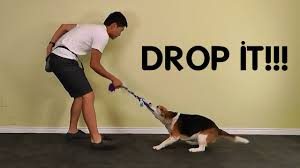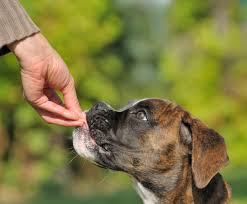Self control is often thought of as an inherent quality-something a dog (or person) either has or doesn’t have. Admittedly, some of us may be more naturally capable of self control than others.
But self control is much more than just behaving calmly or even resisting excitement. It is more than being well trained. It is an emotional skill. Self control can be taught and developed much the way physical skills like loose leash walking can be taught.
How Dogs Learn Self Control
Dogs, like humans, learn self control through life experiences and through interaction with others. They learn from the consequences of their actions when they experiment with behavior.
All types of consequences (both positive and negative experiences) influence the development of self control.
Puppies and young dogs for example, may learn to have self control around dogs during play. If a puppy plays nicely and with restraint (showing good self control) the play session is likely to continue.
However, if the pup bites too hard, becomes too rambunctious, or is otherwise rude or out of control, the other dog may offer a warning and then disengage from the play.
Since most of us live with our dogs in an controlled environment, with fences and leashes that enforce our control, it may be difficult for some dogs to learn self control strictly through their daily interactions, they may need a little help from us.
This is where training for self control comes in. You really can help your dog gain this fundamental skill. Training exercises to teach self control involve three elements:
- Teaching the dog that being calm is an option
- Allowing the dog the opportunity to experiment so that he begins to understand that self control is a rewarding option
- Teaching the dog to listen in the face of excitement or arousal
Step One -It’s Okay to be Calm
For some dogs being calm comes naturally. But many dogs, especially dogs with self control issues, actually need to be taught that being calm is an option and a good choice.
 Sit Calmly. Sit or down are good foundation exercises for self control. When a dog sits and stays sitting (or stays in the down position) for several minutes, he learns how to be calm. A dog who is lacking self control simply does not know that it is possible to sit quietly in the face of distractions. We have to show our dogs that it is possible.
Sit Calmly. Sit or down are good foundation exercises for self control. When a dog sits and stays sitting (or stays in the down position) for several minutes, he learns how to be calm. A dog who is lacking self control simply does not know that it is possible to sit quietly in the face of distractions. We have to show our dogs that it is possible.
Start with practicing sit or down in a low distraction environment for one to five minutes. If your dog has trouble holding a sit or down, you may need to start with only a few seconds and build up slowly to a minute or longer.
Once your dog does well in your living room and other easy places, start practicing out in the world. Slowly increase the difficulty of the distractions. A dog who can sit or down and hang out for several minutes in the face of distractions is learning that being calm is an option.
 Relax in New Places
Relax in New Places
When your dog has the idea of sitting calmly, take the exercise a step further. Teach your dog that he can quietly hang out with you in new but low stimulation environments. Head for a quiet space-perhaps the neighborhood park, under an oak tree in a field, or even a new spot in your backyard. Take a book and perhaps a blanket to sit on. Keep your dog on leash, and invite him to sit or lie down (whichever he is more comfortable with) open your book, and settle in for a few minutes. When your dog settles, quietly praise him.
Sit for Exciting Events
You can reinforce the sit calmly by asking your dog to sit for all exciting events in his life. For example, ask your dog to sit before going outside to run and play, before walking through the front door, before having the leash put on, before being fed dinner, and even before being let off leash to play and interact with other dogs.
Step 2-Self Control is Rewarding
Dogs with good self control have had the opportunity to learn that restraint is a rewarding behavior. These exercises help dogs understand how rewarding it can be to control their own behavior.

 Leave It or Off
Leave It or Off
The “Leave It” or “Off” is when you teach a dog to back away or look away from an interesting object, dog or person. It is commonly used to train puppies to refrain from mouthing or playing with the wrong items, and to help overexcited dogs learn to disengage from other dogs. While this exercise is usually taught as a safety behavior-a way to teach a dog that leaving something alone is the best option-it is also a way to encourage self control.
In the early stages of the off exercise, you may cue the behavior by saying “off” when you want your dog to leave something alone, I like to use the off command for dogs that jump up on people or items, such as tables or counter tops.
You can actually set up a “Leave it practice course” by laying out 5 to 10 interesting objects (toys, cones, socks, food, etc.). Walk through the course one or more times asking your dog to “Leave it” when you pass each object and rewarding him each time he does.
After your dog walks through the course once or twice, he is likely to begin offering the leave it before you even ask. When this happens, jackpot by rapid fire feeding him treats and lavishing with praise.
Watch for opportunities in your daily life, on walks, for example, when your dog notices something or someone and then looks to you. If you can catch these opportunities, you will help your dog learn that disengaging (which is part of self control) is a great choice.
 Wait for the Ball Toss
Wait for the Ball Toss
In the early stages of practicing this game you will want to simply have your dog sit, and then toss the ball as a reward. As he learns the game, you can increase the time he waits before the ball is tossed.
Next, watch for opportunities to reward the offered sit-where your dog actually sits before you ask. Your dog will learn that his act of self offered control (sitting and waiting for the ball toss) is more rewarding than dancing around and demanding the throw. Of course, this means you should limit the number of times that you throw the ball when he is demanding the throw with exuberant behavior, even when you are not actively training him.
Step Three: Calm in the Face of Arousal
Hunting, herding, and even dog sports like agility encourage dogs to exhibit self control while in the midst of excitement and arousal. Here is an at home exercise that also helps dogs learn to turn on and off their excitement, and to listen to you in the face of arousal.
 Tug-Sit-Tug
Tug-Sit-Tug
Tug games can be great fun and exercise. For dogs who get wound up when tugging, this game can be a powerful tool for teaching a dog to exhibit self control even when excited. Start by making sure your dog knows how to “drop” the toy on cue. Start with a calmer version of tug, (at a lower arousal level) and every 3 to 5 seconds stop pulling and ask your dog to drop the toy. At first, if you need to, you can reward your dog for dropping the toy with a treat.
Once your dog will easily and quickly drop the toy on cue, start requesting a sit after he drops it, so the sequence is tug, drop, sit. You can use the tug game as the reward. Begin increasing the length of time that you require your dog to remain sitting before you start tugging.
When your dog gets “good” at this game, start gradually increasing the intensity and excitement of the game by playing harder or longer (five to seven seconds for example) before you ask for the drop and sit. Your dog may start to offer the sit after the drop!
Asking vs. Offering
Several times when describing the above exercise, it is recommended to reward your dog for “offering” a behavior before you ask. When you ask or cue your dog to do a specific behavior, and your dog responds, he is listening to you or under your control.
Sometimes just being able to follow a direction does reveal a degree of self control, but when a dog volunteers a appropriate behavior, especially a behavior that shows restraint or calmness, he is definitely exhibiting self control.
One of the best ways you can encourage self control is to watch for opportunities to reward (reinforce) your dog with praise, attention, or treats when he spontaneously makes a good decision. In addition, note those times when your dog opts for self control in the face of big temptation. Lavish him with praise attention, treats, and other rewards at these times.
 When you selectively reward behaviors that require your dog’s self control in daily life, you have provided the opportunity for him to experiment with behavior and learn that calm, controlled behavior is the best (most rewarding) choice. Let your dog know that you notice and appreciate his good choices.
When you selectively reward behaviors that require your dog’s self control in daily life, you have provided the opportunity for him to experiment with behavior and learn that calm, controlled behavior is the best (most rewarding) choice. Let your dog know that you notice and appreciate his good choices.
Keep it Positive
Some owners ask, “Wouldn’t he learn it faster if we corrected his impulsive behavior”?
Aside from the obvious that training with positive methods is kinder, it is also believed that self control is stronger when it is learned through reinforcement, rather than punishment.
Possibly the best example is the herding dog who exhibits amazing self control around sheep. The dog learns that waiting patiently earns him the reward of working those sheep. Without the reinforcement of getting to move the sheep, the same dog might have a tougher time learning restraint in the face of incredibly strong drives.
Also, attempts to “correct” behavior may accidentally reinforce it. For example, if your dog jumps on you as a way to gain your attention and you scold him, he has just been rewarded for jumping. Scolding is a form of attention. In contrast, if you calmly disengage (showing self control on your part) you ensure the out of control behavior is not inadvertently rewarded. You also send a clear message that being out of control is not going to earn attention.
What can you do if you have a dog who regularly blows it in terms of self control?
First, identify and respect what your dog can and cannot handle. Try not to set him up for failure by putting him in situations where he has (so far) been unable to contain himself.
Then get busy and start training self control behaviors in less challenging settings, and slowly build on his successes.
If you are consistent in managing these tasks, your dog will soon discover that controlling himself-remaining calm in the face of distractions, showing restraint around temptations, and listening when excited-is always the most rewarding choice.
The Whole Dog Journal






